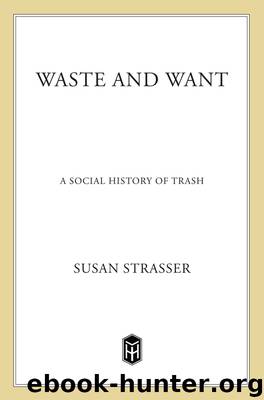Waste and Want by Susan Strasser

Author:Susan Strasser
Language: eng
Format: epub
ISBN: 9781466872288
Publisher: Henry Holt and Co.
CHAPTER FIVE
Making Do and Buying New in Hard Times
Writing in House & Garden in 1930, Richardson Wright, the magazine’s editor and the author of the recent Hawkers and Walkers in Early America, reminisced about peddlers and tinkers. “According to contemporary economists,” Wright asserted, the thrift represented by the “picturesque itinerants” who once bought and repaired the castoffs of middle- and upper-class households would be “the worst sort of citizenship” in Depression America. “We live in a machine age,” he explained. “To maintain prosperity we must keep the machines working, for when machines are functioning men can labor and earn wages. The good citizen does not repair the old; he buys anew. The shoes that crack are to be thrown away. Don’t patch them. When the car gets crotchety, haul it to the town’s dump. Give to the ashman’s oblivion the leaky pot, the broken umbrella, the clock that doesn’t tick. To maintain prosperity we must keep those machines going.”1
Wright used the phrase factor of obsolescence, suggesting that, as the editor of a leading home magazine, he was familiar with Christine Frederick’s recent Selling Mrs. Consumer or that he had picked up the terminology from others who were. But the larger position Wright was pointing to—that economic growth was fueled by what had once been understood as waste—went beyond Frederick’s formulation. It got to the heart of prevailing theories about the causes of the Depression.
Common sense suggested that hard times would get better if people would just spend their money. “This whole depression business is largely mental,” an Indiana newspaper wrote in a 1930 editorial. If every person would just “unwind the red yarn that is wound about his old leather purse … the whole country could join in singing, ‘Happy Days Are Here Again.’” Professional economists, blaming the Depression on “underconsumption,” made essentially the same point.2
But if people were “underconsuming” during the years before Wall Street crashed, they were nevertheless doing so as consumers. Few people made soap anymore; most bought clothing, and sewing was becoming a hobby. When hard times came, most younger people, at least, were already thoroughly consumerist. Their versions of “making do” and watching their wallets when the effects of the crash hit home were framed by consumer concerns and consumer possibilities. People with jobs—three-quarters of the workforce—continued to apply for and receive the credit they had learned to use during the more expansive 1920s, when many bought cars, bedroom sets, and clothing on time. Now they bought refrigerators on time with the excuse that they would save money on food. They stayed home in the evenings to save money but amused themselves with hobbies that cost money, like making quilts from kits.
Depression-era consumers were courted by advertisers and tempted by industrial designers, who set out to loosen the yarn around their purses, vanquishing underconsumption with new colors and designs, new ideas for using products, and better packaging. Industrial design was a “depression baby,” in the words of historian Jeffrey Meikle. Advertising agents and department store
Download
This site does not store any files on its server. We only index and link to content provided by other sites. Please contact the content providers to delete copyright contents if any and email us, we'll remove relevant links or contents immediately.
| Acoustics | Bridges |
| Earthwork Design | Environmental |
| Fire Science | Highway & Traffic |
| Hydrology | Remote Sensing |
| Seismic Design | Structural |
| Structural Dynamics | Surveying & Photogrammetry |
| Transportation |
Whiskies Galore by Ian Buxton(41866)
Introduction to Aircraft Design (Cambridge Aerospace Series) by John P. Fielding(33064)
Small Unmanned Fixed-wing Aircraft Design by Andrew J. Keane Andras Sobester James P. Scanlan & András Sóbester & James P. Scanlan(32743)
Craft Beer for the Homebrewer by Michael Agnew(18140)
Turbulence by E. J. Noyes(7935)
The Complete Stick Figure Physics Tutorials by Allen Sarah(7307)
Kaplan MCAT General Chemistry Review by Kaplan(6866)
The Thirst by Nesbo Jo(6826)
Bad Blood by John Carreyrou(6543)
Modelling of Convective Heat and Mass Transfer in Rotating Flows by Igor V. Shevchuk(6391)
Learning SQL by Alan Beaulieu(6208)
Weapons of Math Destruction by Cathy O'Neil(6139)
Man-made Catastrophes and Risk Information Concealment by Dmitry Chernov & Didier Sornette(5921)
Digital Minimalism by Cal Newport;(5661)
Life 3.0: Being Human in the Age of Artificial Intelligence by Tegmark Max(5474)
iGen by Jean M. Twenge(5366)
Secrets of Antigravity Propulsion: Tesla, UFOs, and Classified Aerospace Technology by Ph.D. Paul A. Laviolette(5309)
Design of Trajectory Optimization Approach for Space Maneuver Vehicle Skip Entry Problems by Runqi Chai & Al Savvaris & Antonios Tsourdos & Senchun Chai(5011)
Electronic Devices & Circuits by Jacob Millman & Christos C. Halkias(4907)
